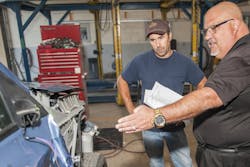For his first month at Abernethy’s Auto Body, John Hayduk described the environment as tense, foreboding, uneasy—essentially, everyone was “walking on eggshells.”
“The manager would just lose it,” Hayduk says. “He would just start screaming and throwing papers and files around, having a meltdown. It was like that every week.”
As the manager-in-training at the time, Hayduk observed everything that was holding back the Avondale, Pa., shop: a disorganized repair process; self-entitled employees; an unwillingness to negotiate with insurance companies; outrageous paint and materials spending; low efficiency and productivity.
And, of course, the elephant in the room: the shop’s inability to evolve.
“The manager had been here since 1969 and was still doing things the way he did them back then,” Hayduk says.
So when Hayduk stepped in, the 53-year-old’s daily schedule and management style brought Abernethy’s into the 21st century: complete disassemblies up front; a quick lane for small repairs; eliminating employees unwilling to adapt; getting paid for all work; getting employees invested in shop-wide success.
While he says the shop staff experienced “culture shock”—which resulted in staff being slashed from 19 to 11 people—employees are now making more money and have invested in the company’s continued growth. Cycle times were cut by one day, productivity doubled (from 2.8 to 5.5 booth cycles per day), efficiency rose by 40 percent, paint and materials gross profits rose by 70 percent, on-time completion rates for jobs over $1,500 rose from 35 to 100 percent, and Abernethy’s had its best sales month of all time in June.
Oh, and one extra detail: Hayduk has accomplished all this in one year.
Abernethy’s Auto Body
Location: Avondale, Pa.
Size: 12,000 square feet
Staff: 12 (4 technicians, 2 painters, 1 prepper, 1 detailer, 1 estimator/manager, 1 CSR, 1 parts manager, 1 owner)
Average Monthly Car Count: 88
Annual Revenue: $2.5 million
My management style is that I don’t micromanage. It’s the complete opposite of what everyone was used to. I give people a task, and I expect them to take ownership if something is not completed on time. If there’s a problem with the paint color, just fix it. You don’t need me to see it. If you’re not happy with something, you’re empowered to make a decision. I just need to know if there’s a problem that affects delivery so I can update the customer. It only becomes a problem if you’re consistently missing deadlines, which is when I’ll pull you aside and address it.
Now I have a great team here that doesn’t need much hand holding, which is really nice.
The first thing I do each day is say “Good morning” to everybody. You have to maintain that communication with everyone. You have to be upbeat. I don’t walk in acting like a grump.
Then I’ll print out a sheet from our management system, which tracks what process the cars are in. I’ll walk out in the body shop and make sure all the cars being worked on in the shop are where they’re supposed to be at.
Then I walk over to paint and check on what their plans are for the day. I spent a lot of time in the beginning—and still do—policing the paint department. We needed to cut down on our inventory. It was hellacious when I got here. They were ordering $25,000 in paint supplies every month, and now we’re down to $11,000.
The other issue we had was our paint shop at the time would only do 2.8 cycles a day. And some painters wouldn’t budge on changing. Eventually it came to the point to where we had to part ways with long-time employees.
Our management system also gives us a projected paint date, so our painters know when they’re supposed to paint each car. Our whole thing is to paint the car that is next to be painted. If you’re ahead of the game, then you’re fine; you can paint them in any order. But if I get a car to you that says it needs to be painted by noon today, don’t skip that car to paint another—that car goes through the booth.
I had to let my estimator go, so right now I’m writing all the estimates, which is what I spend the majority of the day doing. I had to let him go because he wasn’t being thorough enough, and being thorough is the only way to get paid by insurance companies.
I believe the estimate should tell a story. It shouldn’t just be 10 lines. My estimates might be 50, 60 lines. Most of that is included operations and little details about all the work that needs to be done. That’s to let the body tech know that I was thorough. And they need to know that, because their pay is based on efficiency. They need to know how they’re getting paid.
I’ve made it a point to review jobs with technicians. When I first got here, if they took the tail lights out on a bumper job and de-trimmed the trunk to reach a molding, they saw that as basic work that didn’t need to be charged to insurance. They were essentially performing that disassembly on the back of that car for free. You’ve just given an hour and a half of that job away. And it’s just crazy.
You have to take the time to study it. It’s all about educating employees. They have to understand they can ask for it and say to the estimator, “Hey, I had to take the tail lights off, how come I don’t have this on my estimate?” Depending on how busy we get, sometimes the tech will get the car to disassembly, and I might not have seen the car. It might be an insurance estimate, and now techs will come to me and note discrepancies.
At the end of the day, I’m going over our numbers. I’m checking the projected throughputs for the shop, our WIP, our sales for the week, for the month. I see what we have coming in and see what’s realistic target for the month.
I just hired another tech and I’m focusing on increasing our capacity. I don’t want all this work sitting in the parking lot that can’t be worked on. When a car leaves, another should be coming in. We don’t schedule our cars for Monday anymore. We bring the cars in Monday through Friday, so there’s always new cars coming in and cars are always cycling through the shop.
Before I leave, I’m usually doing different things depending on who’s here. Sometimes I’m writing estimates and handling all of the parts. If my CSR isn’t here, that means I’m answering the phone. The big thing is just being available for the guys in the shop when they have questions. It makes a huge difference when you have a big team working together, as opposed to individuals pulling against each other. It just makes things so much easier.

